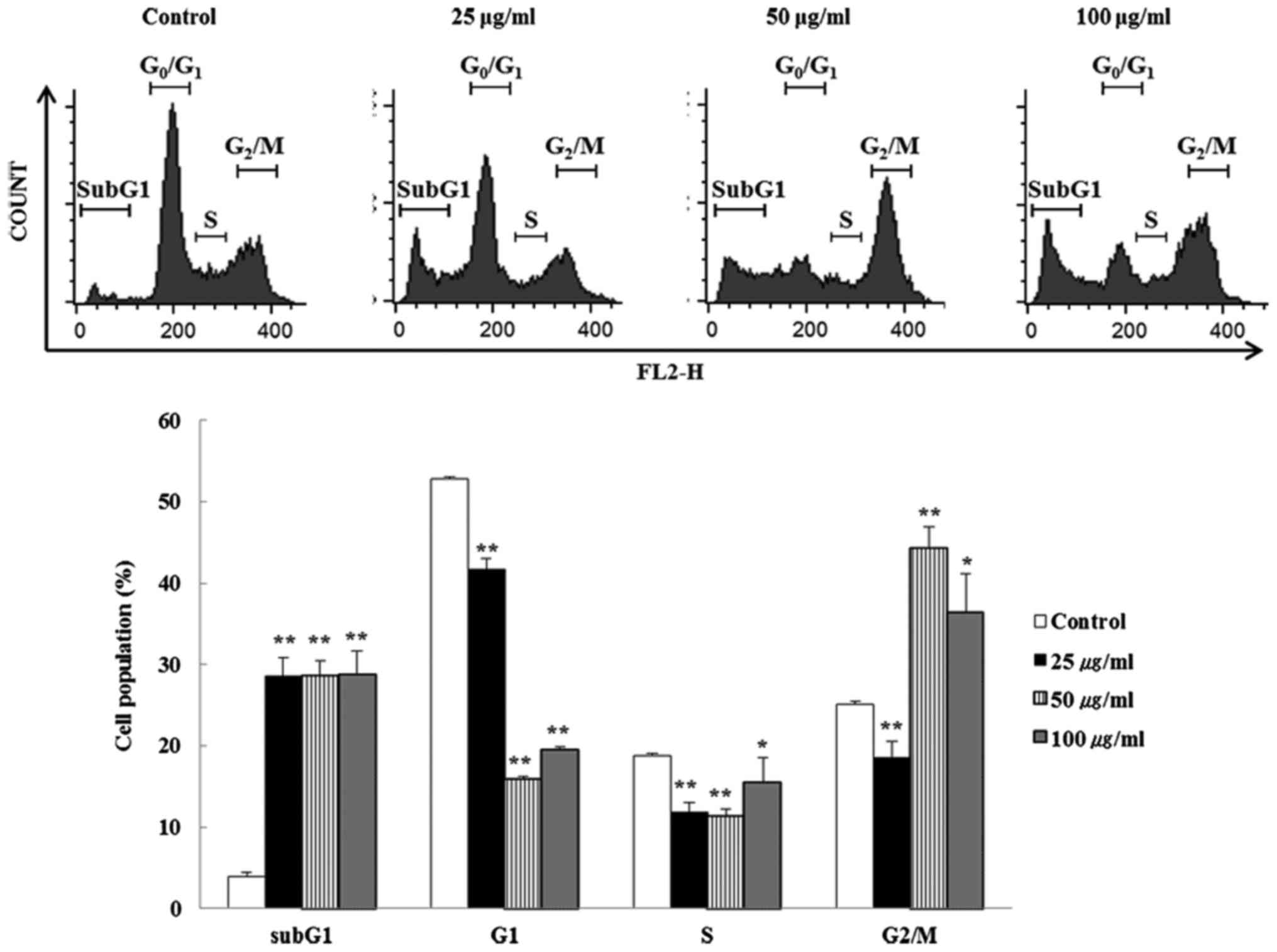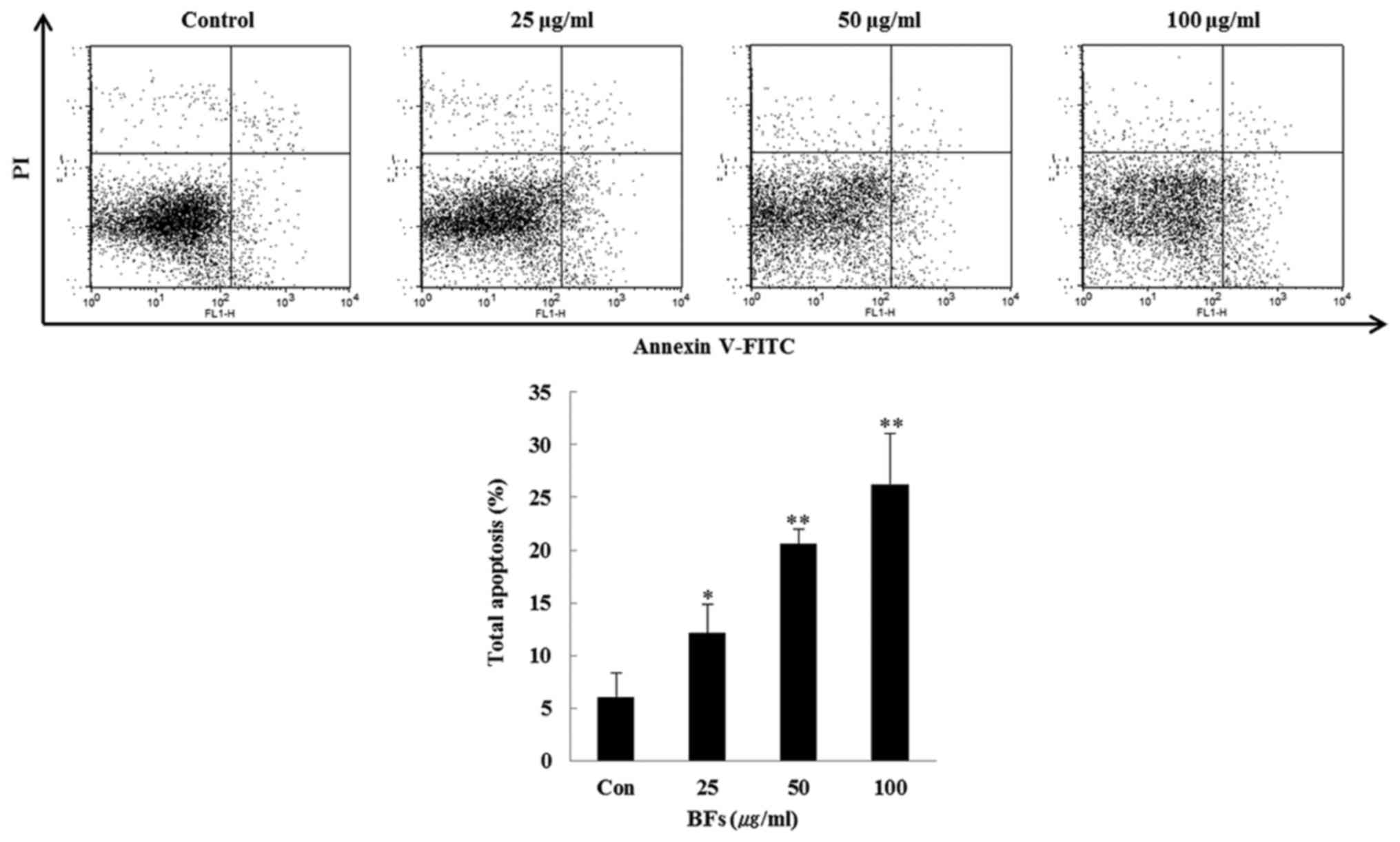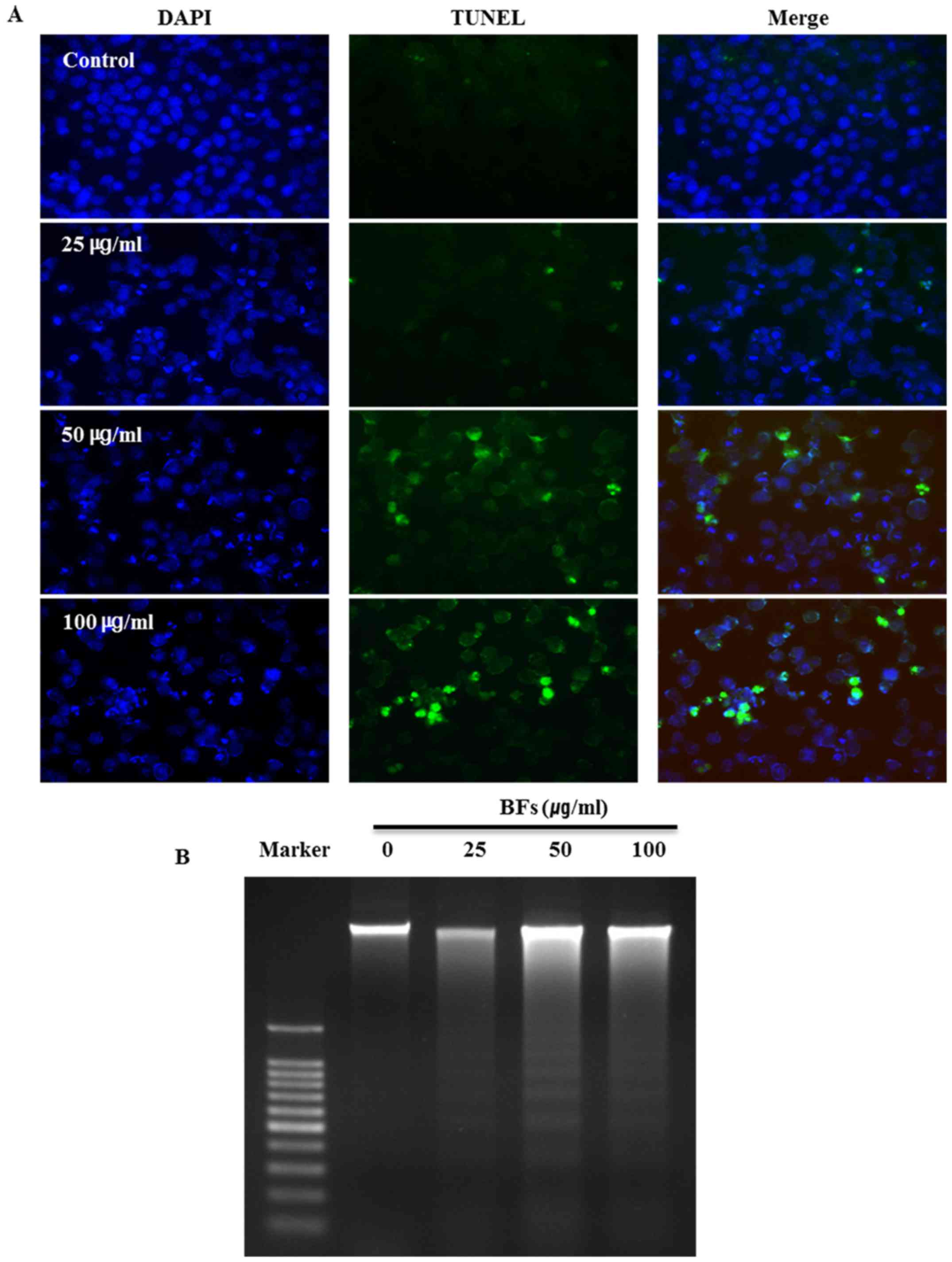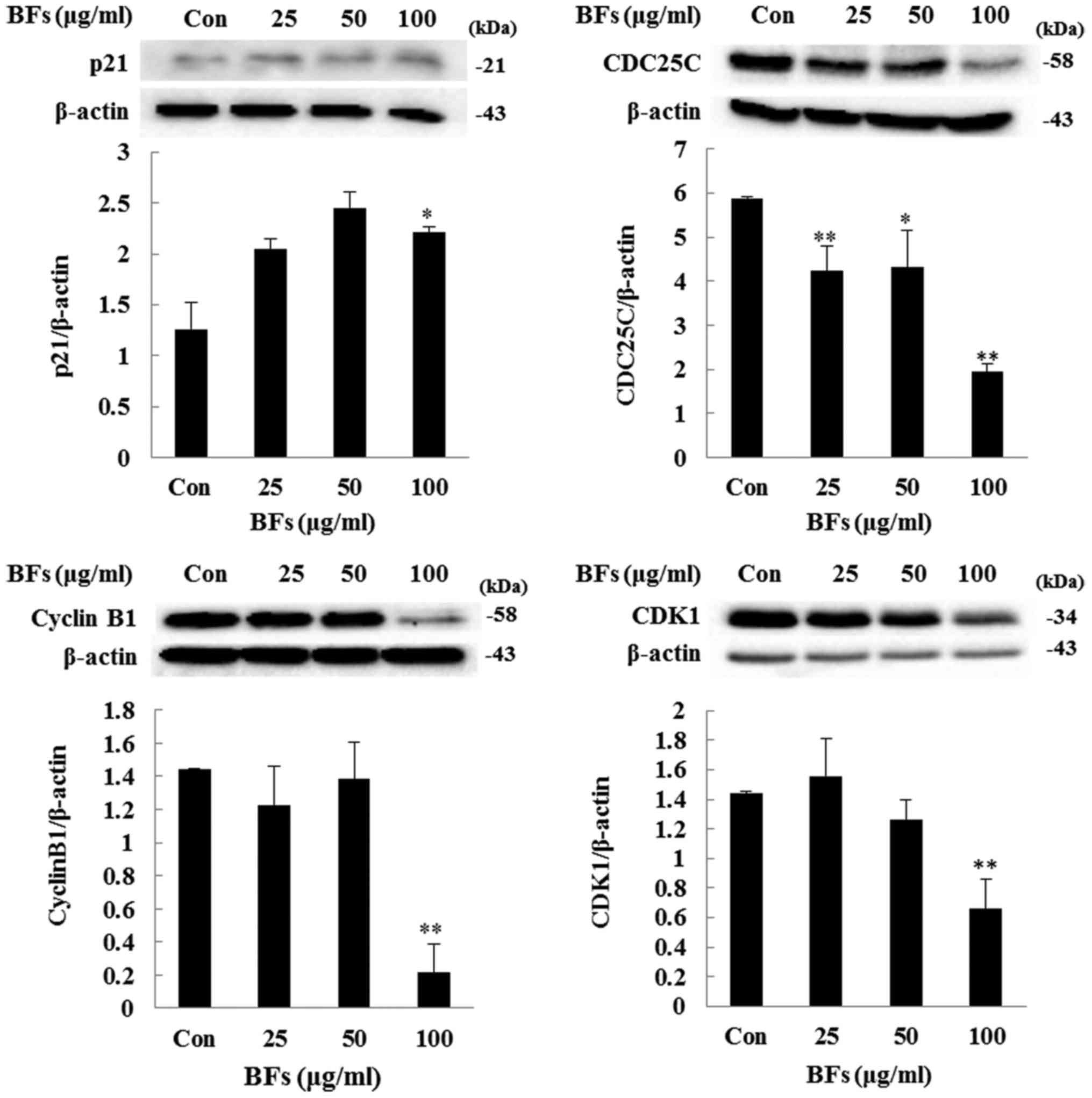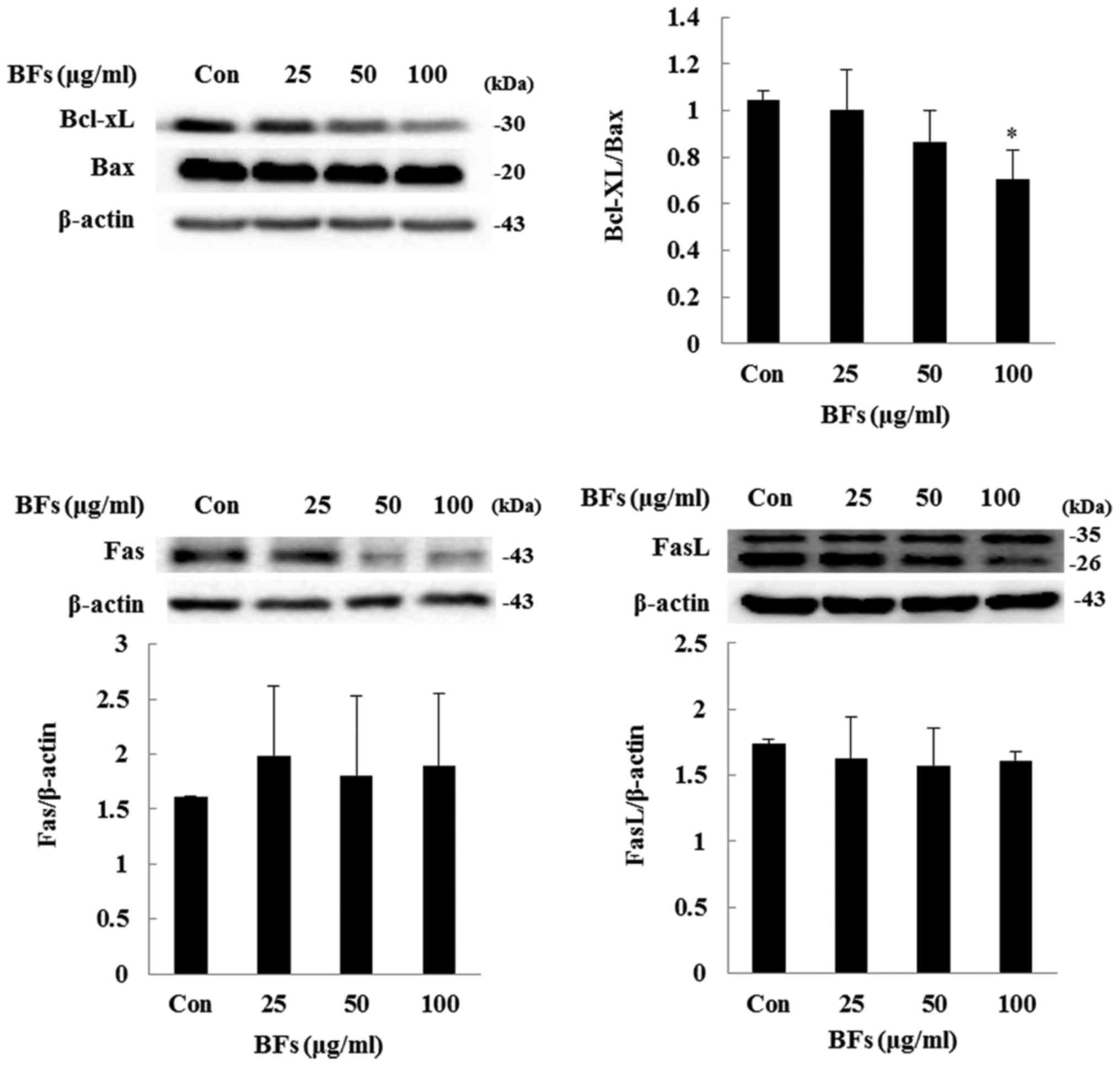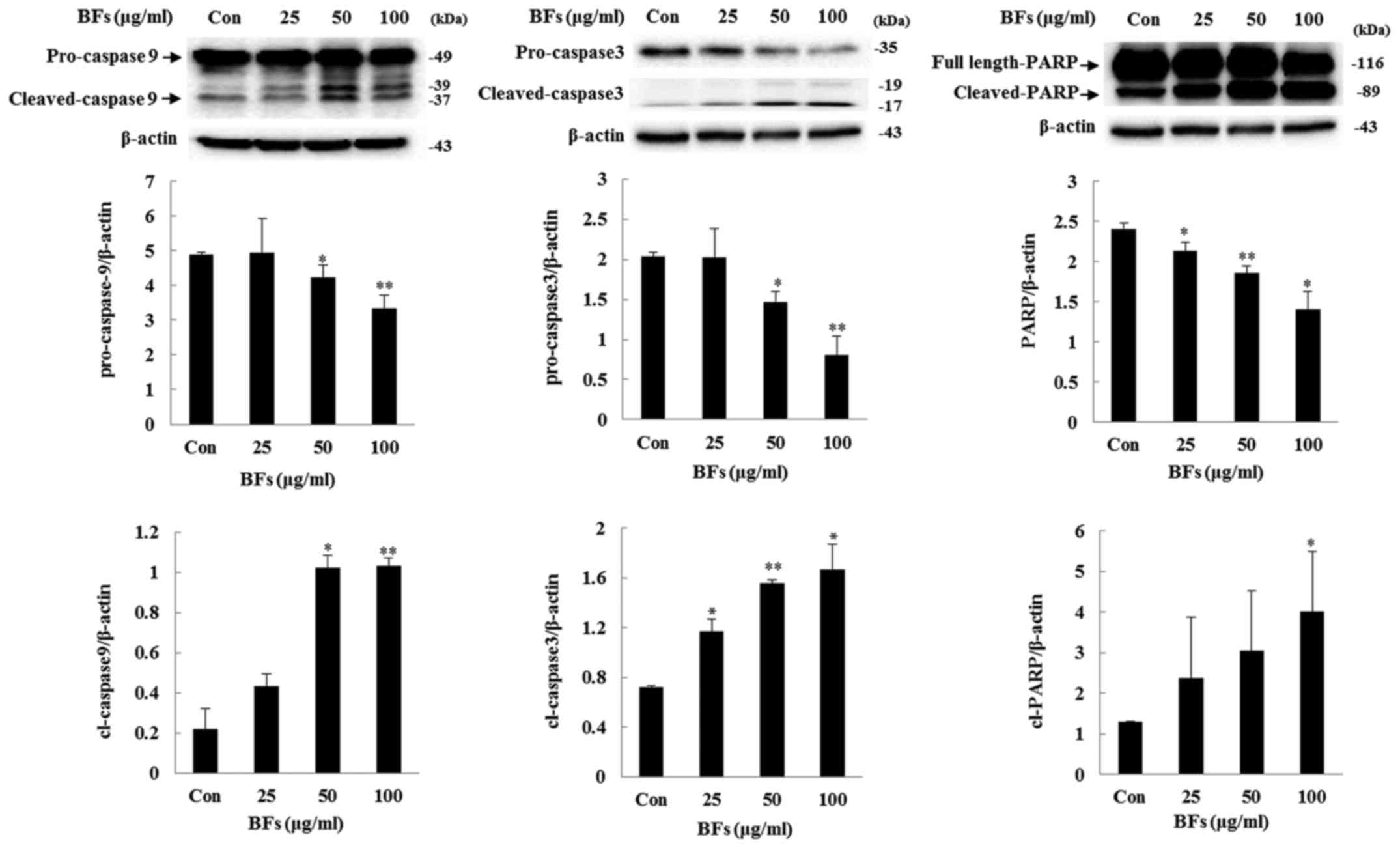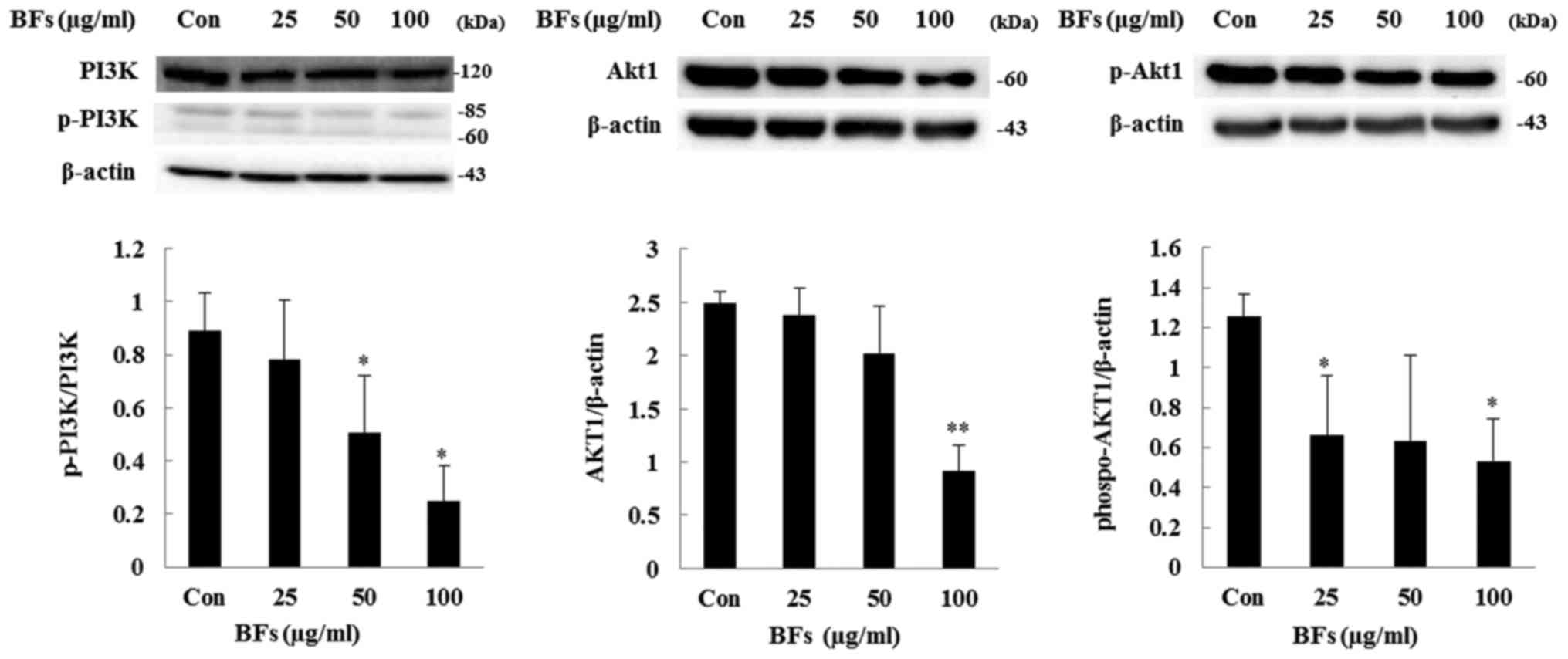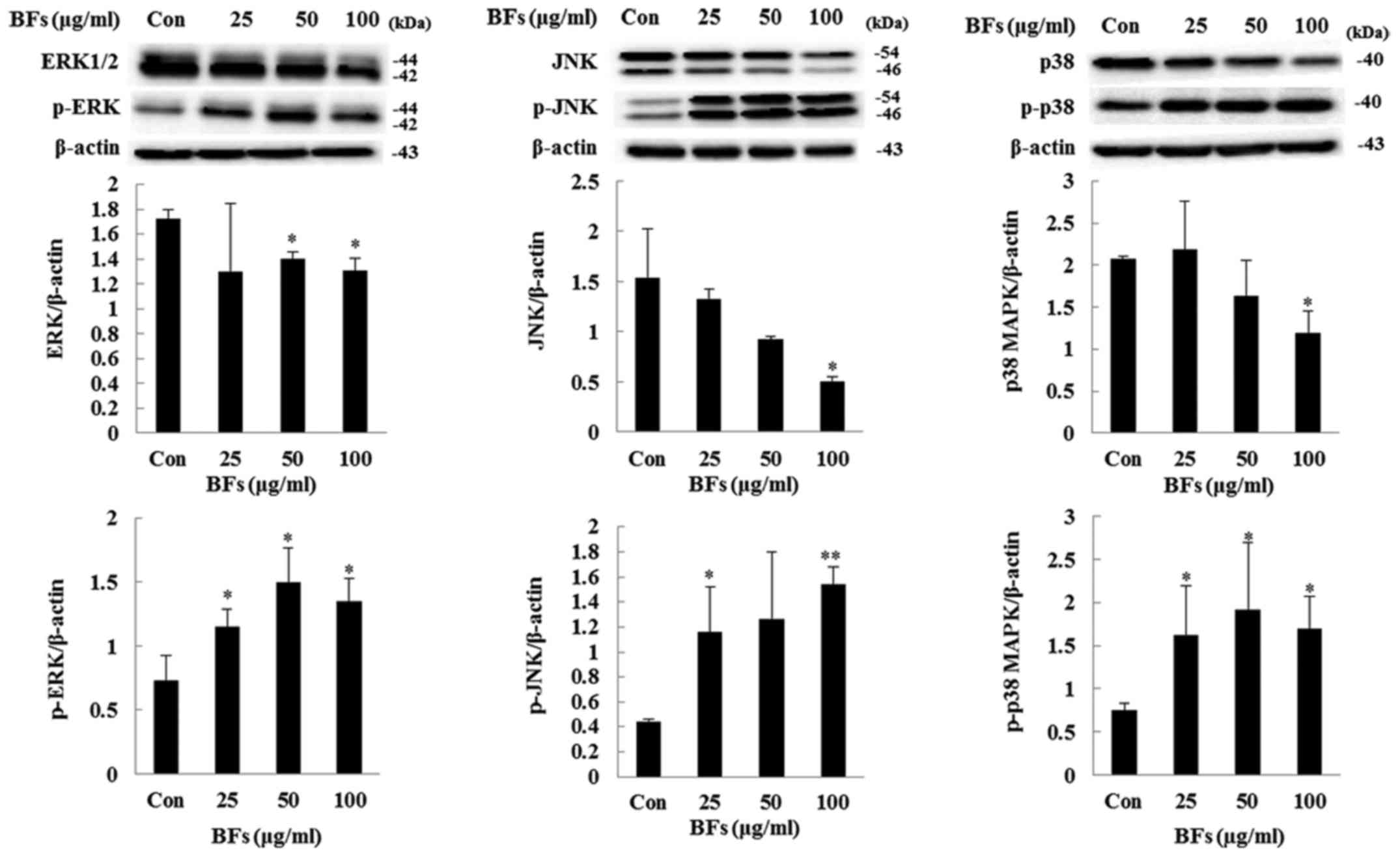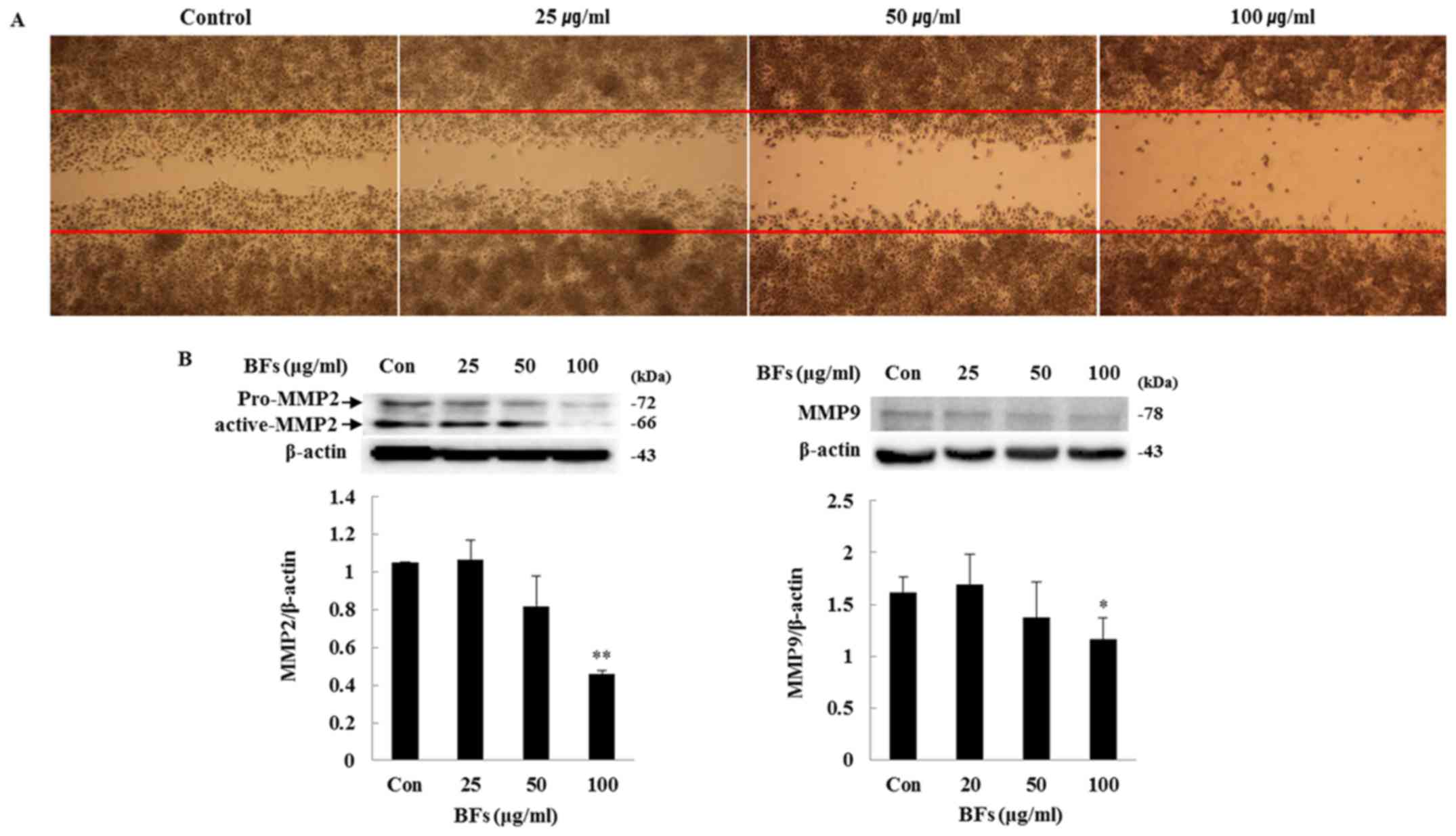Korean Byungkyul - Citrus platymamma Hort.et Tanaka flavonoids induces cell cycle arrest and apoptosis, regulating MMP protein expression in Hep3B hepatocellular carcinoma cells
- Authors:
- Published online on: December 22, 2016 https://doi.org/10.3892/ijo.2016.3816
- Pages: 575-586
Abstract
Introduction
Hepatocellular carcinoma (HCC) is the most common form of liver cancer characterized by cell cycle dysregulation, aberrant angiogenesis, and evasion of apoptosis (1). Liver cancer is considered to be one the most fatal cancers and is the second leading cause of cancer death worldwide. According to WHO, Statistics of Korea in liver cancer death was 22.8% out of 100,000 populations (2nd highest) in 2014, and 745,000 deaths were reportedly in 2012. Administration of chemotherapeutic drugs like cisplatin, 5-fluorouracil, and paclitaxel have been used to cure hepatic cancer, but these preventive measures have raised question due to multidrug resistance proteins and the decrease of apoptotic proteins (2). Additionally, these antineoplastic medications can result in side effects such as nausea, vomiting, loss of appetite, diarrhea, and hair loss. Recently there has been a growing interest in medicinal plants as alternative therapeutic drugs because of their good pharmacological properties and low cellular toxicity.
Flavonoids are natural polyphenolic compounds which are known for their biological activities. Numerous laboratory investigations and human clinical trials revealed cancer chemoprevention and chemotherapy effects of flavonoids by carcinogen inactivation, anti-proliferation, cell cycle arrest, induction of apoptosis and inhibition of angiogenesis (3). Citrus peel has been used as a traditional medicine from ancient time in several Asian countries. Citrus peel is rich in vitamin C, and phytochemicals such as flavonoids, which are quite a remarkable group of phytonutrients and best known for their biological activities including anti-oxidant, anti-inflammation, antibacterial, and anticancer effect (4). Citrus species is now explored as model of natural products carrying valuable phytochemicals that is very promising to be developed in cancer therapy. A large number of research has shown the potential characteristics of citrus fruits as both chemopreventive and co-chemotherapeutic agent (5). Our earlier reported studies have described the mechanism of anticancer effects by Citrus platymamma Hort.et Tanaka in human gastric cancer AGS cells (6). C. platymamma Hort.et Tanaka called as 'Byungkyul' is native to Jeju Island in South Korea. There are two genetic reports of C. platymamma which were provided by Japan (7,8). However, the molecular mechanisms underlying the antitumor effect of C. platymamma on HCC have not been explored yet.
The process of programmed cell death type I (apoptosis), is generally characterized by distinct morphological characteristics and energy-dependent biochemical mechanisms. The ability to modulate the life or death of a cell is recognized for its immense therapeutic potential. Various research continue to focus on the elucidation and analysis of cell cycle machinery and signaling pathways that control cell cycle arrest and apoptosis. The sequence of events which defines the extrinsic phase of apoptosis, are best characterized with the FasL/FasR and TNF-α/TNFR1 models. The intrinsic signaling pathways that initiate apoptosis involve a diverse array of non-receptor-mediated stimuli that produce intracellular signals that act directly on targets within the cell and are mitochondrial-initiated events (9), which is attributed to caspase cascade activation. The biochemical pathways that restrain cell cycle transition and/or induce cell death after stress known to be cell cycle checkpoints, maintain the fidelity of DNA replication, repair, and division and may also result in activation of pathways leading to programmed cell death if cellular damage cannot be properly repaired (10). Key points that induce apoptotic cell death in cancer cells by herbal extract rich in polyphenols and flavonoids lead by cell cytotoxic effect (11), anti-proliferation, growth inhibitory effect (12), DNA fragmentation, cell cycle arrest, endoplasmic reticulum stress (13), following de-activation of major cell regulatory pathways (14,15) and suppression of cell migration and matrix-metalloproteinase (MMPs) activity (16) as MMPs are the key players in the events that underlie tumor dissemination (17) in cancer cells.
Hence in this study treatment of flavonoids from Byungkyul (BFs) induced cell death with the involvement of mitochondria-dependent apoptosis, G2/M cell cycle arrest, and inhibition of cell migration in Hep3B cells. This finding suggests that Korean Byungkyul - C. platymamma Hort.et Tanaka might represent the possibility of developing a new bio-therapeutic agent for HCC treatment.
Materials and methods
Sample preparation and high-performance liquid chromatography-tandem mass spectrometry (HPLC-MS/MS) analysis
C. platymamma Hort.et Tanaka fruits was obtained from the Citrus Genetic Resources Bank, Jeju National University, Korea. The flavonoids were isolated, and high-performance liquid chromatography (HPLC) was performed at the Department of Chemistry, Gyeongsang National University by Professor Sung Chul Shin as described previously (18). The BFs powdered samples were stored at −70°C until further use.
Antibodies and reagents
Antibodies for caspase-3 and -9, cleaved caspase-3 and -9, CDC25C, poly-ADP ribose polymerase (PARP), cleaved-PARP, JNK, p-JNK, p38, p-p38, ERK1/2 and p-ERK1/2, Fas, FasL, PI3K, and p-PI3K were purchased from Cell Signaling Technology (Beverly, MA, USA), and Bax, cyclin B1, CDK1, and β-actin were purchased from Millipore (Temecula, CA, USA), and Akt, p-Akt, MMP-2, and -9 were purchased form Bioworld Technology Inc. (Louis Park, MN, USA), and Bcl-xL was purchased from StressGen Biotechnologies Corp. (Victoria, BC, Canada). All chemicals used in this experiment were of the purest grade available.
Cell culture and BFs treatment
Dulbecco's modified Eagle's medium (DMEM), RPMI-1640 medium, fetal bovine serum (FBS), and antibiotics (streptomycin/penicillin) were purchased from Gibco (Grand Island, NY, USA). Hep3B and HepG2 cells were cultured in DMEM supplemented with 10% fetal bovine serum, and 1% penicillin/streptomycin at 37°C in a humidified atmosphere of 5% CO2. Cells grown to 70 or 80% confluence were untreated (control) or treated with BFs for 24 h in complete cell culture media.
Cell viability assay
Cell viability was measured using MTT assay. Cells were seeded in 48-well plates and incubated overnight, followed by treatment with various concentrations of the BFs for 24 h. MTT solution (5 mg/ml) was added to the cells and incubated for 3 h at 37°C. The formazan precipitate was dissolved in 200 µl of dimethyl sulfoxide (DMSO) for 30 min and absorbance of converted dye was measured at a wavelength of 540 nm using a micro-plate reader. Cell viability was expressed as a percentage of proliferation versus control.
Analysis of cell cycle distribution and cell apoptosis
Flow cytometry was used to analyze cell cycle distribution and cell death. Hep3B cells were treated without or with 25, 50 and 100 µg/ml of BFs for 24 h at 37°C and cells were collected, washed with cold PBS (phosphate-buffered saline), and then centrifuged. For cell cycle assay, harvested cells were fixed with 70% ethanol for 1 h at 4°C, and fixed cells were washed in PBS. 1 U/ml of RNase A (DNase-free) and 5 µg/ml of propidium iodide (PI; Sigma-Aldrich) were then added to the cells and were incubated for 30 min at 4°C in the dark. Cell cycle distribution was then analyzed using a FACsCalibur flow cytometer (BD Biosciences, Franklin Lakes, NJ, USA). For cell death analysis, FITC-Annexin V apoptosis detection kit (BD Pharmingen, San Diego, CA, USA) was used. The harvested cell pellet was suspended in 100 µl of Annexin V binding buffer and incubated with 5 µl of an Annexin V-FITC solution and 5 µl of PI solution at room temperature for 15 min in the dark. After adding 400 µl of binding buffer the samples were analyzed on flow cytometer.
DNA fragmentation assay
Hep3B cells were treated with indicated concentration of BFs (0, 25, 50 and 100 µg/ml) for 24 h and DNA was isolated as described previously (19). Total DNA solutions were then subjected to 1.5% agarose gel electrophoresis and DNA bands were visualized by UV light and documented by photography.
DAPI fluorescent staining
For nuclear morphological analysis, Hep3B cells were incubated with various concentrations of BFs (0, 25, 50 and 100 µg/ml) at 37°C for 24 h. Hep3B cells were fixed with 3.7% paraformaldehyde for 15 min followed by three washes (10 min each) and permeabilized with 1% Triton X-100, later stained with Hoechst 33342 fluorescent dye (20 µg/ml) for 15 min. Nuclear morphology was observed through Leica DM 6000 B fluorescence microscope.
TUNEL assay
DNA damage was measured by DNA fragmentation detection kit (QIA33; Calbiochem, San Diego, CA, USA), according to the manufacturer's instructions. The cells were fixed with 4% paraformaldehyde and incubated with TdT enzyme solution for 90 min at 37°C. After PBS washing, the cells were mounted on DAPI and fluorescent images were observed under a Leica DM 6000 B fluorescence microscope.
Wound healing assay
Migration of Hep3B cells was measured by a wound healing assay. Hep3B cells were cultured on 12-well plates (8×105 cells/well) overnight. After confluent growth, the cells were scratched horizontally with a micropipette tip to obtain a constant straight space devoid of cells. Suspended cells and media were removed and phenol-free medium containing various concentrations of BFs (0, 25, 50 and 100 µg/ml) was added and incubated at 37°C for 24 h. Three randomly selected spaces along the scratched line were photographed using an inverted microscope.
Western blot analysis
Total cell lysates were prepared using with lysis buffer (RIPA) containing protease inhibitor cocktail and EDTA. The 50 µg of lysate protein were separated by 12% polyacrylamide gel following electrophoretical transfer via polyvinylidene membrane. After blocking in Tris-buffered saline-Tween containing 5% skimmed milk powder for 30 min, each membrane was incubated overnight at 4°C with primary antibodies against each target protein. After washing five times, the membranes were incubated with horseradish peroxidase-conjugated secondary antibodies and western blots were developed with ECL kit (GE Healthcare). Normalization was ensured by β-actin and each band was quantified using ImageJ software.
Statistical analysis
The obtained results were expressed as the mean ± standard deviation (SD) of a minimum three replicates in independent experiments. The data were analyzed by unpaired, two tailed Student's t-test using SPSS version 10.0 for Windows (SPSS, Chicago, IL, USA). The statistical significance was accepted as p<0.05 and p<0.01.
Results
Characterization of BFs
Fig. 1 shows the obtained chromatograms of Byungkul extract possessing 15 flavonoid peaks at 280 nm in HPLC. In HPLC-MS/MS derived peaks elaborated as three flavanones namely neoeriocitrin, naringin, and hesperidin along with eight flavones such as isosinensetin, sinensetin, teramethyl-O-isoscutellarein, nobiletin, tetramethoxyflavone, heptamethoxyflavone, tangeretin, and hytroxypentamethoxyflavone, and four unidentified peaks were characterized (Table I).
Effects of BFs on cell viability
The cytotoxicity effect of BFs in HepG2 and Hep3B cells were determined by MTT assay using various concentrations of Byungkul extract (0–1,000 µg/ml). BFs treated cells had different viability effects on HepG2 and Hep3B cells. As observed in Fig. 2 the growth of Hep3B cells were reduced significantly from 25 µg/ml followed by a 50% cell growth inhibition at doses between (100–200 µg/ml) while in HepG2 cells, the cell viability were significantly reduced from 400 µg/ml of BFs treatment at 24-h duration. These results suggest that the effect of BFs treatment on cell viability is more specific to Hep3B than that in HepG2 cells. Thus, Hep3B cells were used for the following experiments.
BFs induce cell cycle alteration and apoptosis in Hep3B cells
The effect of BFs on cell cycle progress in Hep3B cells were investigated by flow cytometry. Cells incubated with different concentrations (0, 25, 50 and 100 µg/ml) of BFs for 24 h were stained with PI-stain and cell cycle distribution was analyzed using a flow cytometer. Fig. 3 shows that G2/M phase was significantly increased in BFs-treated cells when compared with untreated control cells. These data suggest that BFs arrest Hep3B cells in the G2/M phase. In addition, subG1 phase cells were enhanced but G1 phase cells were declined significantly suggesting that BFs induced apoptosis in a dose-dependent manner. Furthermore, FITC-conjugated Annexin V and PI double staining was conducted and it was observed that the late apoptotic cells in BFs treated Hep3B cells were increased dose-dependently when compared with the untreated control cells (Fig. 4).
Effects of BFs on nuclear morphology in Hep3B cells
The influence of BFs on the morphological change and damage of cell nucleus was examined by DAPI and TUNEL assay. All nuclei were stained in blue with DAPI and TUNEL-positive cells are stained in green. DAPI staining shows chromatin pyknosis with intense blue fluorescence and cleaved nuclei as blue granules by BFs treatment (0, 25, 50 and 100 µg/ml). Additionally, TUNEL-positive cells were increased in a dose-dependent manner in BF-treated cells (Fig. 5A). DNA fragmentation is one of the main features of apoptosis therefore DNA ladder assay was conducted by DNA electrophoresis on 1.5% agarose gel after DNA preparation from BF-untreated or BF-treated Hep3B cells for 24 DNA ladder pattern was observed in BF-treated Hep3B cells while there was no ladder formation in untreated control cells (Fig. 5B). These results suggest that cell death in BFs treated Hep3B cells is due to apoptosis.
Regulation of CDK1, cyclin B1, CDC25C, and p21 protein expression in BF-treated Hep3B cells
To further analyze the effect of BFs on cell cycle arrest, investigation has been done to measure the protein expression levels of p21, CDK1, cyclin B1, and CDC25C as they play a major role in cell cycle regulation and cell proliferation. Immunoblot result revealed that, cells treated with different concentrations (25, 50 and 100 µg/ml) of BFs have reduced expression levels of CDK1, cyclin B1, and CDC25C when compared with the untreated cells. In contrast, the protein level of p21, a negative regulator of CDK1/CyclineB1, was induced by BFs treatment in subsequent doses (Fig. 6).
Influence of BFs on the regulators involved in intrinsic apoptosis
In intrinsic pathway or mitochondrial pathway, the balance between Bcl-2 family members such as Bcl-xL and Bax is important while in extrinsic apoptosis pathway Fas and FasL are the key inducers. In both the pathways cleavage of caspases and PARP plays a crucial role (20,21). Fig. 7 shows BF-treatment has significantly reduced ratio between anti-apoptotic proteins Bcl-xL to pro-apoptotic protein Bax at concentration of 100 µg/ml in Hep3B cells. Also, in order to confirm extrinsic factor involvement, western blot analysis of protein expression level of Fas and FasL was performed and it was observed that BF-treatment at various concentrations (0, 25, 50 and 100 µg/ml) did not significantly changed the protein expression of Fas and FasL. Furthermore, treatment of BFs led to significant upregulation of cleaved caspase-3, and -9 as well as PARP expression levels, confirming the involvement of caspase in BF-induced cell death (Fig. 8). These results demonstrated that BFs modulate apoptosis through the intrinsic apoptotic pathway in Hep3B cells.
Regulation of PI3K/AKT and MAPK signaling pathway in Hep3B cells
The PI3K/AKT pathway has been involved in transmitting oncogenic signals. PI3K plays a role in induction and progression of several diseases including cancer and AKT regulates cell growth, cell proliferation, and resistance to apoptosis (22). In this study, western blot assay revealed that treatment with BFs (0, 25, 50 and 100 µg/ml) caused inhibition in the phosphorylation of PI3K and Akt as well as total-Akt protein expression and also phospho-Akt/total-Akt ratio was reduced by BF-treatment (Fig. 9). Moreover, ERK1/2, JNK, and p38 MAPK pathways which are activated by environmental stimuli play important roles in apoptosis induction (23). These signals are activated by phosphorylation. Fig. 10 shows BF-treated Hep3B cells significantly elevate the phosphoryl ation level of ERK1/2, JNK and p38 MAPK in a dose-dependent manner. These above results indicate BFs regulate cell growth and proliferation leading to apoptosis by inactivation of PI3K/Akt and activation of MAPKs pathways in Hep3B cells.
Effect of BFs on cell migration activity
In order to investigate the influence of BFs on Hep3B cell migration, scratch wound migration and western blot assays were conducted. Overnight incubated cells were scratched horizontally with a micropipette tip followed by removal of any cellular debris and detached cells. The wounded cell monolayer was then incubated in fresh complete media with different concentration of BFs (0, 25, 50 and 100 µg/ml) for 24 h and visualized by optical microscope. The wound closure of Hep3B cells was suppressed by different doses of BF-treatment as compared to control cells. Fig. 11A shows that BFs inhibited cell mobility of Hep3B in a dose-dependent manner. Interestingly, western blot analysis also showed that, MMP-2 and MMP-9 protein expression were reduced significantly at 100 µg/ml of BF-treatment (Fig. 11B). Taken together, the data support involvement of BFs in cell migration inhibition.
Discussion
There is an emerging interest in therapeutic potential of medicinal plants on several health benefits, due to their availability with various phytonutrients such as flavonoids which have shown efficacy and safety in the treatment of hepatobiliary dysfunction and digestive complaints earlier (24). In this study, Byungkyul peel extract was identified with 11 flavonoid peaks enlisting-hesperidin, naringin, tangeretin, nobiletin, neoeriocitrin, isosinensetin, sinensetin, teramethyl-O-isoscutellarein, tetramethoxyflavone, heptamethoxyflavone, and hytroxypentamethoxyflavone along with 4 unidentified peaks by HPLC. The HPLC-derived flavonoids indicated that Korean Byungkyul peel contains abundant polymethoxylated flavones.
Several studies have approved that, hesperidin, naringin, nobiletin, and tangeretin have health remedial factors, with roles such as antioxidant, suppressor of carcinogenesis, cell cycle regulator following apoptotic cell death, angiogenesis, metastasis, and as co-chemotherapy (5). Tangeretin, one of the polymethoxylated flavones inhibited cancer cell proliferation, metastasis and invasion of melanoma B16F10 cells, induced G1 cell cycle arrest and apoptosis in breast and colon cancer cells, and suppressed ERK1/2 phosphorylation and growth of human mammary cancer cells (25). In in vivo study, nobiletin, another major polymethoxylated flavone, effectively inhibited skin inflammation and TPA-induced skin tumor formation, reduced the number of carcinomas in colon tissue, and showed chemopreventive effect of colon and prostate cancer. In hepatic cancer, nobiletin blocked cell cycle at G2/M phase, attenuated Bcl-2 expression and induced Bax and caspase-3 in HCC cell line, and also significantly inhibited tumor growth (25).
In the present study it was observed that, the growth of Hep3B cells were reduced significantly from 25 µg/ml in BFs while the cell viability of HepG2 cells were significantly reduced from 400 µg/ml in BF-treatment suggesting that BFs have more effective anti-proliferative and cytotoxic activity in hepatocellular carcinoma Hep3B cells than in HepG2 cells.
Cancer is a life-threatening disease characterized by sustained proliferative signaling, evading growth suppressors, resisting cell death, inducing angiogenesis, and activating invasion and metastasis (26). Tangeretin and nobiletin induced G1 arrest by increasing the expression of p21 in human breast and colon carcinoma cells, and naringin inhibits proliferation and induced G1 arrest by upregulation of p21 in human bladder cancer cells (5). In our previous studies we reported that flavonoids extracted from Korean Citrus aurantium L. induced A549 cells arrest by downregulation of CDC2, CDC 25C, and cyclin B1 and the upregulation of p21 resulted in G2/M arrest in a cell line (27). Similarly, in the present study, it was observed that BFs induced G2/M cell cycle arrest by inhibiting the protein expression of CDC25C, cyclin B1, and CDK1 and induced p21 protein expression.
Flavonoids obtained from C. reticulata peels induced apoptosis on TMK-1, MKN-45, MKN-74, and KATO-III human gastric carcinoma cells and showed anti-proliferative effect on rats liver carcinogenesis model by inducing apoptosis (5). In the present study, Annexin V-PI double staining showed that BF-treated Hep3B cells upregulated apoptotic cell death. Moreover, chromatin condensation, granulation of nucleus and TUNEL positive cells were observed in BF-treated Hep3B cells. Furthermore, different size of DNA fragments was confirmed by DNA fragmentation assay in BF-treated Hep3B cells. These results suggest that the cell death induced by BFs in HEp3B cells is apoptotic cell death.
Apoptotic programs may be initiated by a variety of internal and external stimuli. Caspases play a central role in the execution of the apoptotic process and is activated through either intrinsic or extrinsic apoptotic pathways. Internal stimuli mainly initiate apoptosis through the mitochondrial pathway called intrinsic pathway. In contrast, external stimuli - Fas ligand/Fas receptors are engaged in extrinsic pathways (28). Apoptosis is regulated by counterbalancing pro- and anti-apoptotic members of the Bcl-2 family. Bcl-xL suppresses pro-apoptotic triggering protein Bax via binding to Bcl-xL and Bcl-xL/Bax assembly is embedded in the mitochondrial outer membrane blocking the transfer of pro-apoptotic signaling protein cytochrome c from inside mitochondria. Released cytochrome c activates cascade of caspases and activated caspase-3 cleaves the PARP protein, which is a marker of the apoptosis (26). In this study, Bcl-xL/Bax ratio was reduced in a dose-dependent manner following induced cleavage of caspase-9, caspase-3, and PARP by BFs treatment whereas, the protein expression of Fas and FasL did not alter significantly confirming apoptotic activity of BFs are related to the intrinsic pathway.
The MAPK signaling has a role in regulating gene expression, mitosis, proliferation, motility, metabolism, and programmed cell death (apoptosis) (29). In mammalian, three subfamilies of MAP kinase have been described; extracellular signal-regulated kinase (ERK), c-Jun N-terminal kinase (JNK), and p38-MAP kinase (p38-MAPK) and each MAPK is activated by phosphorylation. In our previous study, it was reported that increase of JNK, and p38 MAPK phosphorylation leads to induction of apoptosis and the increase of ERK1/2 phosphorylation is involved in the G2/M cell cycle arrest mechanism caused by polyphenolic extract of Lonicera japonica Thunb. in HepG2 cells (15). Evodiamine derived from herbal medicine Evodia rutaecarpa results in phosphorylation of JNK thus inducing apoptotic cell death and G2/M phase arrest in human colon cancer cells (30). ERK is characterized as survival signal messenger however, Wang et al, demonstrated that ERK activation is required for induction of cisplatin-induced apoptosis in HeLa cells (31). Similarly, BF-stimulated phosphorylation of ERK, JNK, and p-38 MAPK in Hep3B cell is associated to apoptotic cell death.
PI3K/AKT signaling is one of the major signaling pathways activated in human cancer including HCC and is therefore considered as a suitable molecular target for cancer therapy. Akt is known to regulate various cellular pathways that promote cell survival, cell proliferation, angiogenesis, and invasion. Akt is activated via PI3K pathway which is linked to the development of HCC (32). The present study showed that BFs suppressed phosphorylation of PI3K and Akt1, and also the expression of pan-Akt1. It has been reported that, Akt1 anti-sense oligonucleotide (AS) reduced Akt1 protein expression in both normal and cancer cells. Akt1 AS treatment significantly reduced cancer cell growth and induced cancer cell apoptosis. However, there was no predominant diminution in normal cell growth and survival due to Akt1 AS treatment (33).
Cancer metastasis is the spread of cancer cells to tissues and organs resulting in the death of most cancer patients. Invasion and metastasis of solid tumors require dissolution of the basement membrane, and matrix metalloproteinases (MMPs) including MMP-2 and MMP-9 have an ability to degrade extracellular matrix of the invading surrounding tissues (34). MMP-2 and MMP-9 overexpression is involved in tumor recurrence and metastasis, and the activation of MMPs induced HCC invasion in HepG2 and PLC cells (35). Very widely known flavonoids viz., lutelin and quercetin inhibit cell metastasis in human epidermoid carcinoma cell line A431 (36) and nobiletin attenuates metastasis via both ERK and PI3K/Akt pathways in HepG2 cells (37) as earlier reported. In this study, to characterize the role of C. platymamma in metastasis wound healing assay and protein expression of MMP-2 and MMP-9 were studied. It was observed that BFs suppressed the expression of MMP-2 and MMP-9 and also reduced wound closure of Hep3B cells suggesting its role as an anti-metastatic agent.
In conclusion, BFs can suppress the propagation of hepatocellular carcinoma Hep3B cells via MAPKs and PI3K/AKT pathway. The flavonoids of Byungkyul peel induced apoptosis with the rise of pro-apoptotic protein caspase-3 and -9 and PARP cleavage, and diminution of anti-apoptotic protein Bcl-xL, and induced G2/M phase arrest by suppressing CDK1, cyclin B1, and CDC25C protein expression and promoting expression of p21. Moreover, BFs reduced the protein expression of MMP-2 and MMP-9 which are crucial molecular factors in cell metastasis and invasion. These results indicate the potential beneficial role of C. platymamma as natural product to be developed as agent for human HCC treatment. Therefore, further study needs to be conducted to explore the effectiveness of individual flavonoids in overcoming cancer both in vitro and in vivo. We expect further study will validate the effectiveness of C. platymamma against cancer.
Acknowledgments
This study was suppo2rted by the National Research Foundation of Korea (NRF) funded by the Ministry of Science, ICT and Future Planning (no. 2012M3A9B8019303) and the National R&D Program for Cancer Control, Ministry for Health, Welfare and Family affairs, Korea (no. 0820050).
References
|
Schlachterman A, Craft WW Jr, Hilgenfeldt E, Mitra A and Cabrera R: Current and future treatments for hepatocellular carcinoma. World J Gastroenterol. 21:8478–8491. 2015. View Article : Google Scholar : PubMed/NCBI | |
|
Manosroi A, Akazawa H, Kitdamrongtham W, Akihisa T, Manosroi W and Manosroi J: Potent antiproliferative effect on liver cancer of medicinal plants selected from the thai/lanna medicinal plant recipe database 'MANOSROI III'. Evid Based Complement Alternat Med. 2015:3971812015. View Article : Google Scholar | |
|
Ren W, Qiao Z, Wang H, Zhu L and Zhang L: Flavonoids: Promising anticancer agents. Med Res Rev. 23:519–534. 2003. View Article : Google Scholar : PubMed/NCBI | |
|
Tripoli E, Guardia ML, Giammanco S, Majo DD and Giammanco M: Citrus flavonoids: Molecular structure, biological activity and nutritional properties: A review. Food Chem. 104:466–479. 2007. View Article : Google Scholar | |
|
Meiyanto E, Hermawan A and Anindyajati: Natural products for cancer-targeted therapy: Citrus flavonoids as potent chemopreventive agents. Asian Pac J Cancer Prev. 13:427–436. 2012. View Article : Google Scholar : PubMed/NCBI | |
|
Lee HJ, Nagappan A, Park HS, Hong GE, Yumnam S, Raha S, Saralamma VV, Lee WS, Kim EH and Kim GS: Flavonoids isolated from Citrus platymamma induce mitochondrial-dependent apoptosis in AGS cells by modulation of the PI3K/AKT and MAPK pathways. Oncol Rep. 34:1517–1525. 2015.PubMed/NCBI | |
|
Penjor T, Yamamoto M, Uehara M, Ide M, Matsumoto N, Matsumoto R and Nagano Y: Phylogenetic relationships of citrus and its relatives based on matK gene sequences. PLoS One. 8:e625742013. View Article : Google Scholar : PubMed/NCBI | |
|
Shimizu T and Yano K: A post-labeling method for multiplexed and multicolored genotyping analysis of SSR, indel and SNP markers in single tube with bar-coded split tag (BStag). BMC Res Notes. 4:1612011. View Article : Google Scholar : PubMed/NCBI | |
|
Elmore S: Apoptosis: A review of programmed cell death. Toxicol Pathol. 35:495–516. 2007. View Article : Google Scholar : PubMed/NCBI | |
|
Pietenpol JA and Stewart ZA: Cell cycle checkpoint signaling: Cell cycle arrest versus apoptosis. Toxicology. 181–182:475–481. 2002. View Article : Google Scholar | |
|
Hsu SC, Kuo CL, Lin JP, Lee JH, Lin CC, Su CC, Lin HJ and Chung JG: Crude extracts of Euchresta formosana radix induce cytotoxicity and apoptosis in human hepatocellular carcinoma cell line (Hep3B). Anticancer Res. 27B:2415–2425. 2007. | |
|
Nair SV, Hettihewa M and Rupasinghe HP: Apoptotic and inhibitory effects on cell proliferation of hepatocellular carcinoma HepG2 cells by methanol leaf extract of Costus speciosus. BioMed Res Int. 2014:6370982014. View Article : Google Scholar : PubMed/NCBI | |
|
Yoon SB, Lee YJ, Park SK, Kim HC, Bae H, Kim HM, Ko SG, Choi HY, Oh MS and Park W: Anti-inflammatory effects of Scutellaria baicalensis water extract on LPS-activated RAW 264.7 macrophages. J Ethnopharmacol. 125:286–290. 2009. View Article : Google Scholar : PubMed/NCBI | |
|
Granado-Serrano AB, Martín MA, Bravo L, Goya L and Ramos S: Quercetin induces apoptosis via caspase activation, regulation of Bcl-2, and inhibition of PI-3-kinase/Akt and ERK pathways in a human hepatoma cell line (HepG2). J Nutr. 136:2715–2721. 2006.PubMed/NCBI | |
|
Park HS, Park KI, Lee DH, Kang SR, Nagappan A, Kim JA, Kim EH, Lee WS, Shin SC, Hah YS, et al: Polyphenolic extract isolated from Korean Lonicera japonica Thunb. induce G2/M cell cycle arrest and apoptosis in HepG2 cells: Involvements of PI3K/Akt and MAPKs. Food Chem Toxicol. 50:2407–2416. 2012. View Article : Google Scholar : PubMed/NCBI | |
|
Park KI, Park HS, Kang SR, Nagappan A, Lee DH, Kim JA, Han DY and Kim GS: Korean Scutellaria baicalensis water extract inhibits cell cycle G1/S transition by suppressing cyclin D1 expression and matrix-metalloproteinase-2 activity in human lung cancer cells. J Ethnopharmacol. 133:634–641. 2011. View Article : Google Scholar | |
|
Stamenkovic I: Matrix metalloproteinases in tumor invasion and metastasis. Semin Cancer Biol. 10:415–433. 2000. View Article : Google Scholar | |
|
Hong GE, Kim JA, Nagappan A, Yumnam S, Lee HJ, Kim EH, Lee WS, Shin SC, Park HS and Kim GS: Flavonoids identified from Korean Scutellaria baicalensis Georgi inhibit inflammatory signaling by suppressing activation of NF-κB and MAPK in RAW 264.7 cells. Evid Based Complement Alternat Med. 2013:9120312013. View Article : Google Scholar | |
|
Saralamma VV, Nagappan A, Hong GE, Lee HJ, Yumnam S, Raha S, Heo JD, Lee SJ, Lee WS, Kim EH, et al: Poncirin induces apoptosis in AGS human gastric cancer cells through extrinsic apoptotic pathway by up-regulation of fas ligand. Int J Mol Sci. 16:22676–22691. 2015. View Article : Google Scholar : PubMed/NCBI | |
|
Kim MS, Bak Y, Park YS, Lee DH, Kim JH, Kang JW, Song HH, Oh SR and Yoon DY: Wogonin induces apoptosis by suppressing E6 and E7 expressions and activating intrinsic signaling pathways in HPV-16 cervical cancer cells. Cell Biol Toxicol. 29:259–272. 2013. View Article : Google Scholar : PubMed/NCBI | |
|
Park HY, Kim GY, Moon SK, Kim WJ, Yoo YH and Choi YH: Fucoidan inhibits the proliferation of human urinary bladder cancer T24 cells by blocking cell cycle progression and inducing apoptosis. Molecules. 19:5981–5998. 2014. View Article : Google Scholar : PubMed/NCBI | |
|
Jokinen E, Laurila N and Koivunen JP: Alternative dosing of dual PI3K and MEK inhibition in cancer therapy. BMC Cancer. 12:6122012. View Article : Google Scholar : PubMed/NCBI | |
|
Wagner EF and Nebreda AR: Signal integration by JNK and p38 MAPK pathways in cancer development. Nat Rev Cancer. 9:537–549. 2009. View Article : Google Scholar : PubMed/NCBI | |
|
Kumar S and Pandey AK: Chemistry and biological activities of flavonoids: An overview. Sci World J. 2013:1627502013. View Article : Google Scholar | |
|
Rawson NE, Ho C and Li S: Efficacious anti-cancer property of flavonoids from citrus peels. Food Sci Hum Wellness. 3:104–109. 2014. View Article : Google Scholar | |
|
Hanahan D and Weinberg RA: Hallmarks of cancer: The next generation. Cell. 144:646–674. 2011. View Article : Google Scholar : PubMed/NCBI | |
|
Park KI, Park HS, Nagappan A, Hong GE, Lee DH, Kang SR, Kim JA, Zhang J, Kim EH, Lee WS, et al: Induction of the cell cycle arrest and apoptosis by flavonoids isolated from Korean Citrus aurantium L. in non-small-cell lung cancer cells. Food Chem. 135:2728–2735. 2012. View Article : Google Scholar : PubMed/NCBI | |
|
Jain MV, Paczulla AM, Klonisch T, Dimgba FN, Rao SB, Roberg K, Schweizer F, Lengerke C, Davoodpour P, Palicharla VR, et al: Interconnections between apoptotic, autophagic and necrotic pathways: Implications for cancer therapy development. J Cell Mol Med. 17:12–29. 2013. View Article : Google Scholar : PubMed/NCBI | |
|
Wada T and Penninger JM: Mitogen-activated protein kinases in apoptosis regulation. Oncogene. 23:2838–2849. 2004. View Article : Google Scholar : PubMed/NCBI | |
|
Chien CC, Wu MS, Shen SC, Ko CH, Chen CH, Yang LL and Chen YC: Activation of JNK contributes to evodiamine-induced apoptosis and G2/M arrest in human colorectal carcinoma cells: A structure-activity study of evodiamine. PLoS One. 9:e997292014. View Article : Google Scholar : PubMed/NCBI | |
|
Wang X, Martindale JL and Holbrook NJ: Requirement for ERK activation in cisplatin-induced apoptosis. J Biol Chem. 275:39435–39443. 2000. View Article : Google Scholar : PubMed/NCBI | |
|
He X, Zhu Z, Johnson C, Stoops J, Eaker AE, Bowen W and DeFrances MC: PIK3IP1, a negative regulator of PI3K, suppresses the development of hepatocellular carcinoma. Cancer Res. 68:5591–5598. 2008. View Article : Google Scholar : PubMed/NCBI | |
|
Liu X, Shi Y, Han EK, Chen Z, Rosenberg SH, Giranda VL, Luo Y and Ng SC: Downregulation of Akt1 inhibits anchorage-independent cell growth and induces apoptosis in cancer cells. Neoplasia. 3:278–286. 2001. View Article : Google Scholar : PubMed/NCBI | |
|
Lou L, Ye W, Chen Y, Wu S, Jin L, He J, Tao X, Zhu J, Chen X, Deng A, et al: Ardipusilloside inhibits survival, invasion and metastasis of human hepatocellular carcinoma cells. Phytomedicine. 19:603–608. 2012. View Article : Google Scholar : PubMed/NCBI | |
|
Zhao XL, Sun T, Che N, Sun D, Zhao N, Dong XY, Gu Q, Yao Z and Sun BC: Promotion of hepatocellular carcinoma metastasis through matrix metalloproteinase activation by epithelial-mesenchymal transition regulator Twist1. J Cell Mol Med. 15:691–700. 2011. View Article : Google Scholar | |
|
Huang YT, Hwang JJ, Lee PP, Ke FC, Huang JH, Huang CJ, Kandaswami C, Middleton E Jr and Lee MT: Effects of luteolin and quercetin, inhibitors of tyrosine kinase, on cell growth and metastasis-associated properties in A431 cells overexpressing epidermal growth factor receptor. Br J Pharmacol. 128:999–1010. 1999. View Article : Google Scholar : PubMed/NCBI | |
|
Shi MD, Liao YC, Shih YW and Tsai LY: Nobiletin attenuates metastasis via both ERK and PI3K/Akt pathways in HGF-treated liver cancer HepG2 cells. Phytomedicine. 20:743–752. 2013. View Article : Google Scholar : PubMed/NCBI |





